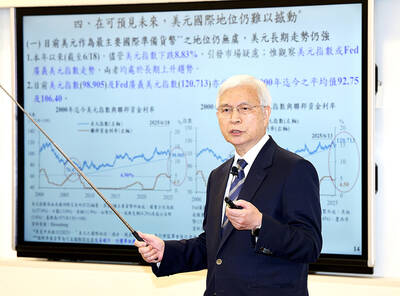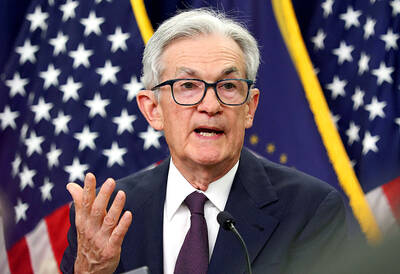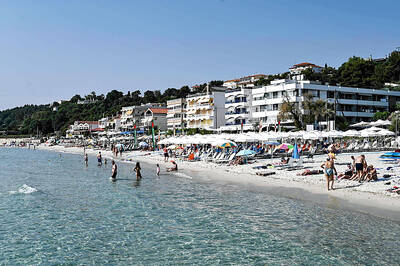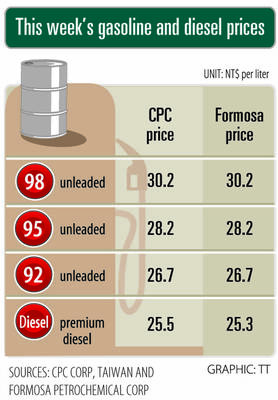AU Optronics Corp (AUO, 友達光電) yesterday posted its smallest quarterly loss in nine months on rebounding demand for televisions, primarily from China, and said it may return to profitability this quarter.
AUO, the world’s No. 3 flat-panel maker, said it would step up capacity expansion, including restarting construction of its second advanced eighth-generation (8G) plant in central Taiwan to cope with growing demand for TVs.
The company also raised capital spending by around 25 percent to NT$75 billion (US$2.29 billion) for this year, from a previous estimate of NT$60 billion, to support capacity expansion at its existing 8.5G and 7G plants.
During the April-June period, AU Optronics lost NT$6.6 billion, from a NT$20.22 billion loss in the first quarter, as prices bounced back on better demand. The Hsinchu-based liquid-crystal-display (LCD) panel maker earned NT$20.39 billion in the second quarter of last year.
“The second quarter [this year] was a very hot season, as Chinese shopping groups and customers necessitated increased supply. It was very different from last year,” AUO vice president Paul Peng (彭雙浪) said, citing better-than-expected sales of TV sets in major markets such as China, the US and Europe.
Peng said the recovery would gain force during the current quarter.
“We are unable to fully satisfy customer demand. We can only supply 80 percent of orders,” Peng said.
The recovery may help boost panel prices by another 10 percent or 15 percent in the July-September period from the US$789 per square meter they reached after an increase of nearly 7 percent last quarter, AUO said.
The price increase in the second quarter helped AUO’s gross margin return to positive territory, or 1.4 percent, for the first time since the final quarter of last year.
Building on the upbeat outlook, AUO chief executive Chen Lai-juh (陳來助) said: “I’m confident that AUO will be profitable in the third quarter ... and we are not seeing any adverse factors in the fourth quarter.”
Yuanta Securities (元大證券) analyst Dale Gai (�?s) said AUO had beat most analysts’ expectations by posting a smaller-than-expected quarterly loss for the second quarter, and it may again report higher earnings than his earlier estimate of NT$4.26 billion this quarter on the back of faster growth in shipments.
AUO said shipments of PC monitor and TV panels were likely to rise by between 15 percent and 20 percent to a record high this quarter, compared with 22.4 million units in the second quarter, AUO said.
“We are also impressed with AUO’s ability to minimize the negative impact of glass substrate supply constraints on its shipments,” Gai said.
He gave a “buy” rating on AUO.
AUO said insufficient supplies of glass substrates would curtail shipments by no more than 5 percent this quarter.
Shares of AUO rose 0.39 percent to NT$38.20 yesterday, compared with a target price of NT$43 set by Gai.

NOT JUSTIFIED: The bank’s governor said there would only be a rate cut if inflation falls below 1.5% and economic conditions deteriorate, which have not been detected The central bank yesterday kept its key interest rates unchanged for a fifth consecutive quarter, aligning with market expectations, while slightly lowering its inflation outlook amid signs of cooling price pressures. The move came after the US Federal Reserve held rates steady overnight, despite pressure from US President Donald Trump to cut borrowing costs. Central bank board members unanimously voted to maintain the discount rate at 2 percent, the secured loan rate at 2.375 percent and the overnight lending rate at 4.25 percent. “We consider the policy decision appropriate, although it suggests tightening leaning after factoring in slackening inflation and stable GDP growth,”

DIVIDED VIEWS: Although the Fed agreed on holding rates steady, some officials see no rate cuts for this year, while 10 policymakers foresee two or more cuts There are a lot of unknowns about the outlook for the economy and interest rates, but US Federal Reserve Chair Jerome Powell signaled at least one thing seems certain: Higher prices are coming. Fed policymakers voted unanimously to hold interest rates steady at a range of 4.25 percent to 4.50 percent for a fourth straight meeting on Wednesday, as they await clarity on whether tariffs would leave a one-time or more lasting mark on inflation. Powell said it is still unclear how much of the bill would fall on the shoulders of consumers, but he expects to learn more about tariffs

Greek tourism student Katerina quit within a month of starting work at a five-star hotel in Halkidiki, one of the country’s top destinations, because she said conditions were so dire. Beyond the bad pay, the 22-year-old said that her working and living conditions were “miserable and unacceptable.” Millions holiday in Greece every year, but its vital tourism industry is finding it harder and harder to recruit Greeks to look after them. “I was asked to work in any department of the hotel where there was a need, from service to cleaning,” said Katerina, a tourism and marketing student, who would

i Gasoline and diesel prices at fuel stations are this week to rise NT$0.1 per liter, as tensions in the Middle East pushed crude oil prices higher last week, CPC Corp, Taiwan (台灣中油) and Formosa Petrochemical Corp (台塑石化) said yesterday. International crude oil prices last week rose for the third consecutive week due to an escalating conflict between Israel and Iran, as the market is concerned that the situation in the Middle East might affect crude oil supply, CPC and Formosa said in separate statements. Front-month Brent crude oil futures — the international oil benchmark — rose 3.75 percent to settle at US$77.01